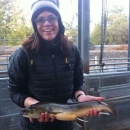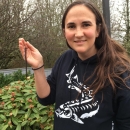National Fish Hatcheries (NFHs) produce fish that provide commercial and recreational fishing opportunities, fulfil tribal trust and mitigation responsibilities and contribute to the recovery of threatened and endangered species. Managing the threat of aquatic invasive species invasive species
An invasive species is any plant or animal that has spread or been introduced into a new area where they are, or could, cause harm to the environment, economy, or human, animal, or plant health. Their unwelcome presence can destroy ecosystems and cost millions of dollars.
Learn more about invasive species (AIS) is one of the ongoing challenges hatchery managers face. Fish hatcheries may be more susceptible to AIS invasion given their stable environment (i.e., water flow, temperature) and increased nutrient output. Many hatcheries are also located in close proximity to popular river access points such as boat ramps and hiking trails where AIS may be spread by recreational activities. Routine hatchery operations including the transport of fish or eggs to another hatchery, the movement of fish distribution equipment (e.g., fish hauling truck, tank, nets, transfer water) and fish stocking, each have the potential to introduce or spread AIS to new waterbodies or between hatchery facilities (ANSTF 2007). The U.S. Fish and Wildlife Service (USFWS) has widely adopted the use of Hazard Analysis and Critical Control Point (HACCP) planning to prevent the introduction and spread of invasive species through human-mediated pathways. These plans often recommend regular visual inspections of hatchery facilities and grounds to potentially detect AIS before they become established within a facility or inadvertently spread to new areas. Early detection is the most important, yet most challenging aspect of AIS management. Discovery of a new AIS infestation can be particularly difficult if the organism is small, cryptically colored or occurs in a habitat that is difficult to sample effectively. Traditional survey techniques may not reliably detect invasive species when an infestation first occurs, or abundance is low. A more sensitive detection tool such as environmental DNA (eDNA) can be employed in addition to visual presence/absence surveys to increase the chances of early detection.
Publication date
Type of document
Annual Report
Facility
Program
Species
FWS and DOI Region(s)




